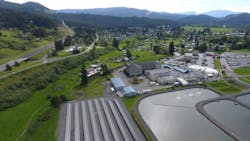Enabling Microgrids for the Underserved: $14.7M DOE plan for Remote DERs, Tribes
Impacts from climate disasters such as heat waves, flooding and tornadoes are most likely to hit poorer communities harder because of equipment limitations, and grid resiliency measures such as microgrids can help mitigate those sometimes fearsome damages.
Microgrid solutions have already produced positive results in tribal communities such as Blue Lake Rancheria in California, Igiugig in Alaska and the Quinault Nation’s Taholah Village in Washington state. Underserved, remote villages can withstand the otherwise dangerous consequences of power outages if they have a backup and island-able resource at the ready.
To that end, the U.S. Department of Energy announced it would provide $14.7 million in a funding opportunity announcement (FOA) for a multi-year research, development and demonstration of microgrid and related technologies for underserved and indigenous communities. The DOE’s Office of Electricity will join with research partners on exploring numerous options and resources.
These explorations could provide deeper understanding of renewable energy, battery storage, multi-nodal small-scale high voltage direct current, advanced demand-side management and microgrid control systems. It also would try to address non-technical barriers such as a lack of local expertise and supply chain challenges.
“I recently had the opportunity to visit Alaska to learn about the unique needs of the state’s remote communities, and I saw firsthand how critical microgrids are to bringing reliable and resilient electric power to the people who live and work there,” said Gene Rodrigues, DOE assistant secretary for electricity, in a statement. “This FOA is one important element of our commitment to meet Americans where they are and work with the local resources available to their communities.”
Under the Biden administration, microgrids have become an energy resiliency and sustainability priority for the federal government. Last year, the U.S. Army released a climate strategy aiming for a microgrid at every installation by 2035.
The Complex Work of Installing a Microgrid at every US Army Base
Session at this year's Microgrid Conference in Anaheim
Get Ready to Celebrate the Revolution in Energy: Microgrid 2024 at Baltimore Harbor
The goal of this latest DOE microgrid initiative for underserved and tribal communities to improve grid reliability, decarbonize power delivery through clean and distributed energy resources and decrease microgrid costs some 15 percent over this decade.
Native American communities are among the poorest in the U.S. and they are often remote communities with less advanced technology connections to such things as high-speed internet and energy infrastructure. Earlier this month, the DOE detailed some $207.6 million in grid resilience project funding for tribal communities through the Bipartisan Infrastructure Act.
One of the best known and decorated tribal microgrid projects is for the 91-acre Blue Lake Rancheria property in Humboldt County of northern California. The Blue Lake Rancheria microgrid includes about 500 kW in solar photovoltaic arrays, a 1,950-kWh battery storage system and a 1-MW legacy backup generator and a control system.
The Blue Lake Rancheria recently united with nearby nations Hoopa Valley Tribe and Karuk Tribe on a request to develop “nested mcirogrids” or a cluster of connected microgrids to help support emergency services in these remote areas. The trio, assisted by the nearby Schatz Energy Research Center, has proposed a $500 million project connecting three front-of-meter 1-MW microgrids.
About the Author
Rod Walton, Microgrid Knowledge Managing Editor
Managing Editor
For Microgrid Knowledge editorial inquiries, please contact Managing Editor Rod Walton at [email protected].
I’ve spent the last 15 years covering the energy industry as a newspaper and trade journalist. I was an energy writer and business editor at the Tulsa World before moving to business-to-business media at PennWell Publishing, which later became Clarion Events, where I covered the electric power industry. I joined Endeavor Business Media in November 2021 to help launch EnergyTech, one of the company’s newest media brands. I joined Microgrid Knowledge in July 2023.
I earned my Bachelors degree in journalism from the University of Oklahoma. My career stops include the Moore American, Bartlesville Examiner-Enterprise, Wagoner Tribune and Tulsa World, all in Oklahoma . I have been married to Laura for the past 33-plus years and we have four children and one adorable granddaughter. We want the energy transition to make their lives better in the future.
Microgrid Knowledge and EnergyTech are focused on the mission critical and large-scale energy users and their sustainability and resiliency goals. These include the commercial and industrial sectors, as well as the military, universities, data centers and microgrids. The C&I sectors together account for close to 30 percent of greenhouse gas emissions in the U.S.
Many large-scale energy users such as Fortune 500 companies, and mission-critical users such as military bases, universities, healthcare facilities, public safety and data centers, shifting their energy priorities to reach net-zero carbon goals within the coming decades. These include plans for renewable energy power purchase agreements, but also on-site resiliency projects such as microgrids, combined heat and power, rooftop solar, energy storage, digitalization and building efficiency upgrades.

